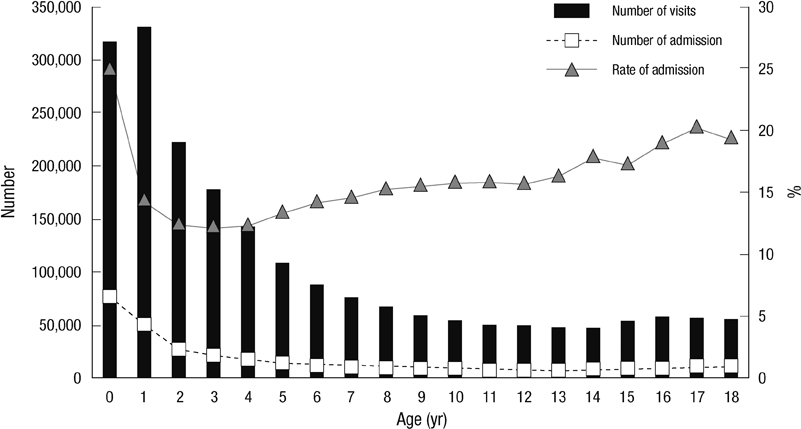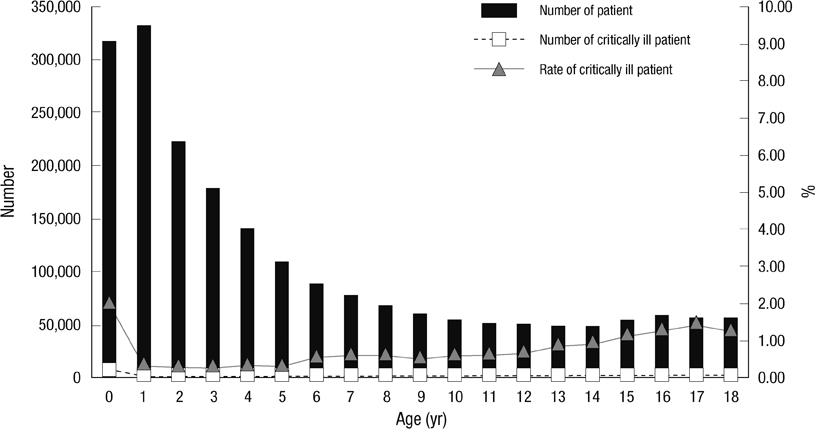J Korean Med Sci.
2012 Oct;27(10):1222-1228. 10.3346/jkms.2012.27.10.1222.
Utilization of Emergency Department by Children in Korea
- Affiliations
-
- 1Department of Emergency Medicine, Seoul National University College of Medicine, Seoul, Korea.
- 2Department of Emergency Medicine, Soonchunhyang University Seoul Hospital, Seoul, Korea. emedhy@schmc.ac.kr
- KMID: 1778830
- DOI: http://doi.org/10.3346/jkms.2012.27.10.1222
Abstract
- This study was conducted to examine the nation-wide emergency department (ED) utilization pattern by children in Korea. Most referral hospital EDs provide their essential ED information to the National Emergency Medical Center through the National Emergency Department Information System (NEDIS). We analyzed the NEDIS data on pediatric visits (< 19 yr old) during three years, from June 1, 2008 to May 31, 2010. A total of 2,072,664 children visited 124 EDs during the study period, and this patient population comprised 31.2% of the total ED visits. Male patients with a mean age of 5.44 (+/- 5.40 SD) yr comprised 59.1% of the ED pediatric visits. Among all age groups, the 1-4-yr-old group was the largest (42.3%). The most common mode of arrival was non-emergency medical service (EMS) (90.7%), and only 4.2% of patients used EMS transport. Common chief complaints in infants were fever (37.4%), whereas many older children presented to the EDs with abdominal pain (15.4%). The ratio of disease versus injury as the cause of ED visits was 2.5:1. Most patients were discharged (81.2%), and 15.3% were admitted. In conclusion, the most common age group who are brought to EDs in Korea is 1 to 4 yr-old young children, and common chief complaints of the visiting children are age-dependent, such as fever in younger children and abdominal pain and headache in older children. We need more improved and organized emergency medicine service system for children in Korea.
Keyword
MeSH Terms
Figure
Reference
-
1. Nawar EW, Niska RW, Xu J. National Hospital Ambulatory Medical Care Survey: 2005 emergency department summary. Adv Data. 2007. (386):1–32.2. Alpern ER, Stanley RM, Gorelick MH, Donaldson A, Knight S, Teach SJ, Singh T, Mahajan P, Goepp JG, Kuppermann N, et al. Epidemiology of pediatric emergency medicine research network: the PECARN Core Data Project. Pediatr Emerg Care. 2006. 22:689–699.3. Li G, Lau JT, McCarthy ML, Schull MJ, Vermeulen M, Kelen GD. Emergency department utilization in the United States and Ontario, Canada. Acad Emerg Med. 2007. 14:582–584.4. Acworth J, Babl F, Borland M, Ngo P, Krieser D, Schutz J, Pitt R, Cotterell E, Jamison S, Neutze J, et al. Patterns of presentation to the Australian and New Zealand Paediatric Emergency Research Network. Emerg Med Australas. 2009. 21:59–66.5. Zimmer KP, Walker A, Minkovitz CS. Epidemiology of pediatric emergency department use at an urban medical center. Pediatr Emerg Care. 2005. 21:84–89.6. Rehmani R, Norain A. Trends in emergency department utilization in a hospital in the Eastern region of Saudi Arabia. Saudi Med J. 2007. 28:236–240.7. Tchah H, Yun DR. Utilization patterns of pediatric emergency room. J Korean Pediatr Soc. 1989. 32:897–914.8. Yoo JW, Lee JH. Clinical analysis of pediatric patients who visited a general hospital emergency center. Korean J Pediatr. 2010. 53:314–322.9. Jeon HJ, Kim SS, Bae HA, Yoo IY. Utilization status of emergency medical service for children. J Korean Acad Child Health Nurs. 2008. 14:5–13.10. Christoffel KK. Effect of season and weather on pediatric emergency department use. Am J Emerg Med. 1985. 3:327–330.
- Full Text Links
- Actions
-
Cited
- CITED
-
- Close
- Share
- Similar articles
-
- A Prospective Study on Emergency Room Utilization in Children with Nonsurgical Gastrointestinal Disorders
- Role of the Korean Triage and Acuity Scale to predict resource utilization in pediatric emergency center
- Pediatric Emergency Department Utilization and Coronavirus Disease in Daegu, Korea
- A study on the pathway for severe emergency patients visiting emergency departments to establish regionalization of emergency medical services in Busan, Ulsan, and Gyeongsangnam-do regions
- The impacts of the COVID-19 pandemic on emergency care utilization in patients with major emergency diseases in Chungnam Province




